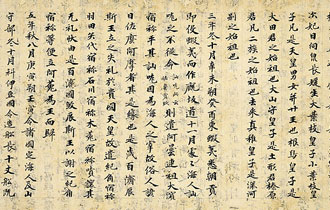Pages |
Hagakure is a loose collection of Yamamoto Tsunetomo's stories, history, and homilies as recorded by Tashiro Tsuramoto, a younger samurai about whom we know little else. Although several English translations exist, they represent only a portion of the total extant text (the original has been lost). The content has no clear structure and is often contradictory. It is also anti-intellectual, essentially representing a conglomeration of Buddhist and Confucian thought and local custom. Moreover, Hagakure is often at odds with the writings of Yamaga Sokōand is critical of the actions of forty-seven rōnin because they waited rather acting immediately. Thus, Hagakure is an idealized created memory of warrior behavior that was not very widely read for more than a hundred and fifty years after it was written.
As these brief discussions of important texts show, there was no cohesive thought, text, or code during the Edo period. The word bushidō was not even very common throughout the pre-modern period. This does not mean that there was no discussion of the rules and qualities desirable in a member of the warrior class. Some, like Tsunetomo, emphasized military readiness, but others emphasized literacy and the ability to act like a gentleman. Most notable is that all these writings occur at a time when the warrior class was no longer at war. The warrior class was in part seeking justification for their position as rulers in times of peace.
In 1868, internal weaknesses, exacerbated by the forced opening of ports to Western trade, led to the downfall of the shogunate. The new government, although primarily run by an oligarchy of samurai, was established on the idea that true Japanese polity should center on the emperor. This event is known today as the Meiji Restoration. Since the establishment of the Kamakura shogunate, Japan had consisted of semi-autonomous states. Shintō, the indigenous religion of Japan, was forcibly stripped of syncretic elements and reconstructed to support the emperor as the originator of Japan. This newly molded belief system is referred to as State Shintō. Similarly, after the Restoration, bushidō, a disparate set of ideas and opinions, was reconstructed to promote unity and patriotism where there had been none.
What is striking about this process is that what ever form of bushidō that had actually existed in Tokugawa times emphasized class differences. The writings were about what warriors needed to do to remain elite. Meiji bushidō was all inclusive, suggesting that the real Japanese were warriors and those values represented all of Japan. This was clear in the implementation of universal conscription. This dramatic break from the past was not popular with anyone; the warrior class did not want to give up the status that carrying weapons had conferred on them while commoners did not want to give up their heirs at their most productive age. The ministries of army and navy appropriated the idea of bushidō to create a sense of unity. A set of instructions issued to the new conscripts told them they should have loyalty, decorum, faith, obedience, courage, frugality, and honor because these qualities “made up the substance of bushidō of old.”[ii]
Pages |











